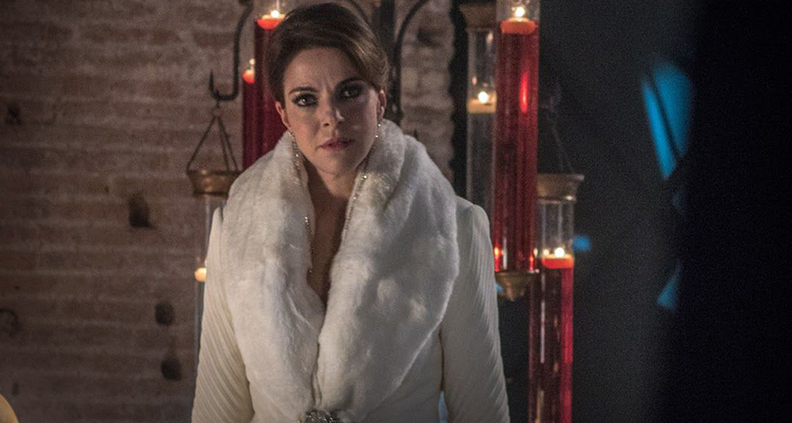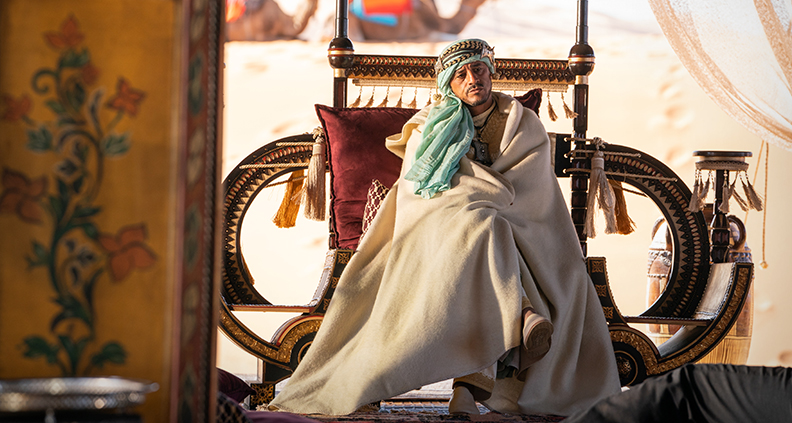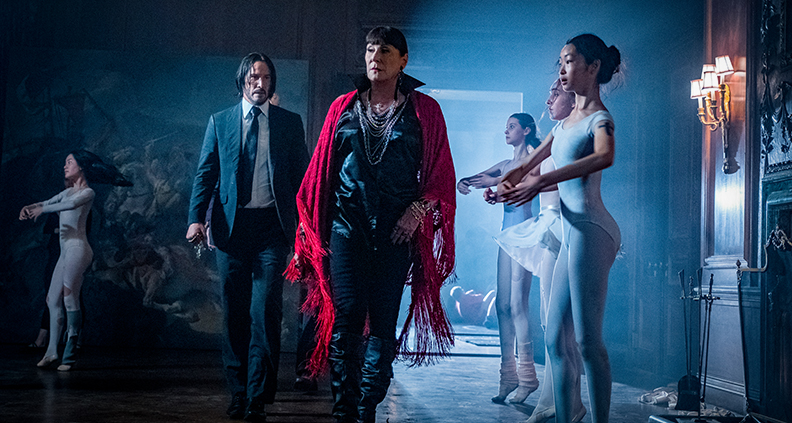In Part One of our two-part interview with Luca Mosca, the costume designer talked about his inspirations for the sartorial canvas of the John Wick franchise — from Keanu Reeve’s titular assassin’s iconic style, and how he likens his job to dressing a troupe of dancers. Now, we go deeper into how he and his team ensured that their costumes would survive director Chad Stahelski’s fluid and intense action choreography, and how he personally sewed a portion of what became co-star Angelica Huston’s accouterment.
In John Wick: Chapter 2, you play John’s tailor in the montage where he picks out his weapons and suits up in preparation for the Rome catacombs assassination. Mosca: I was honored that Chad and Keanu gave me the opportunity. I was pretty nervous, but when the moment came I just did my scene and welcomed John to Rome as an old and respected acquaintance. That scene ended up being in the trailer. Did Chad or Keanu give you any advice on acting? Mosca: Chad’s advice was very simple: “I want you to just act. This is your life, this is your calling.” Although I continue to get great satisfaction from designing, I love acting as well. I’ll be acting in two short films this month and three others that are in post-production (including A Door and When Fire Flies.) John specifically requests that the lining of his suit be “tactical” and we’ve seen him hold his suit jacket up as a bulletproof shield when facing a barrage of bullets. Is his entire suit bulletproof? Mosca: Yes! The entire three-piece suit is supposed to be made from bulletproof fabric. This fabric is technology that exists in the real world — bullets won’t penetrate the fabric, but the force from the ballistic impact will shatter one’s ribs. John frequently wrestles his opponents to the ground with Judo throws and Sambo takedowns before he executes the headshot. How does his tie and jacket not get in the way? Do you use a lot of pins? Mosca: We don’t like to pin or tape things, because what really makes John Wick action such a feast for the eyes is the action sequences are very organically choreographed, so we actually welcome these little happy “accidents.” A tie hurling into the air or a jacket flapping when he goes for a quick draw, I think they make it so much more visually appealing. The production must go through a ton of suits with the endless grappling, knife-fights and chokeholds! Mosca: [laughs] Tell me about it! We have racks after racks of suits that look the same, but are totally different. To produce 20 shirts with the same puncture wounds and blood splatter for a specific sequence, our team works with a template to position the blood in the exact spot on 20 shirts, so the blood oozes out of the central wound in the exact pattern, because all the “multiples” need to be identical. Is it true that on Chapter 3, you created 180 individual suits for Keanu? Mosca: John starts the movie with a clean suit, and then as the story progresses, he gets cut up, shot at, choked, pummeled and stabbed. For each stage of the suit, we have dozens of them because some are for Keanu, and others are for the bad guys and the stunt team. So each stage of the suit becomes a different costume and preserving continuity can be a nightmare. Whose job is it to keep track of all this? Mosca: The Costume Supervisor breaks down the script and knows exactly what stage each costume is in and which scene it’s for. We have one costumer in charge of what’s going on with Keanu. The script supervisor on set also adds another level of scrutiny to make sure any error gets caught. Nowadays with digital color correction, some things are added onto the costumes in post. In Chapter 3, John rides through New York hanging off the side of a horse while shooting several ninjas charging at him on motorcycles. Keanu was wired into a rig system for this sequence. How did you have to modify his suit? Mosca: That series of suits is full of holes to accommodate the wires and rigging, then later removed with CG and VFX in post. What was your vision for the character Gianna D’Antonio’s (Claudia Gerini) lustrous silver gown? Mosca: We had a first-rate team of tailors in Rome putting these outfits together to encapsulate Gianna’s power, wealth and elegance. The John Wick underworld is a world of fantasy and exquisite taste. So I wanted Gianna’s attire to embody that. With the secretaries at the High Table headquarters, what was the inspiration for the tattoos and pencil skirts with a 1960s vibe? Mosca: The tattoos were written on the page, but the rest were mine. The tattoos added an edgy flavor to the secretaries. Even though they are wearing pencil skirts and plain sleeveless blouses, the tattoos and elaborate accessories brought out a fierce-yet-elegant energy to them. What went into designing the ensemble for The Bowery King, played by Lawrence Fishburne? Mosca: When I was in Japan, a friend took me to see a dressing ceremony for the Lady of the Twelve Layers, which fascinated me. Jūnihitoe (十二単)—“twelve-layer robe”—is a set of intricate kimonos worn in the Japanese royal court. Lawrence’s character runs the assassins who move around New York undetected, posing as homeless guys. In New York, you’ll see the homeless often wearing layers and layers, probably to combat the bone-chilling cold. That’s how his costume was birthed — many coats fused into one garment. What inspired the look of the leader of the High Table — “The Elder” (Saïd Taghmaoui)–who rules over the assassin underworld from the Sahara Desert? Mosca: The Elder is surrounded by the nomadic “Tuareg” tribe. Traditionally, their clothes are in darker shades of royal blue and black. We thought, “what if we totally go against tradition?” That’s how we came up with white ecru cape made of wool, a linen tunic and linen undershirt for the mystical powerful figure who rules the underworld. It was all handmade and embroidered by our tailors. The Director (Angelica Huston) is a mysterious figure from John’s past who operates the ballet academy that doubles as an assassin boot camp where John was molded into the lethal force we see today. How did you want the audience to see her? Mosca: She used to be a Russian gypsy. As soon as I heard “gypsy,” the first image that came to mind was of a crimson red shawl with fringes adorning her black satin base costume. But the shawl I envisioned was nowhere to be found. When I finally discovered these red fringes in New York, I was so excited that I couldn’t wait until the next day. So I sewed it myself in my apartment that night, and this gorgeous shawl came to life. It’s one of the costumes that I’m most proud of in my career. Angelica is such a rock star and transformed into a roaring tiger during the costume fitting — so proud, threatening and powerful. The expansion of the John Wick assassin underworld has been touted as one of the best examples of world building in recent years. What does this mean to you? Mosca: With the latter films, I spent more time dressing the background, like the extras in the Roman catacombs rock concert [in Chapter 2] and the guests and wait staff in Casablanca’s Continental Hotel [in Chapter 3]. When we were in Morocco for Chapter 3, we bought authentic trim in Casablanca to tailor the uniforms, capes and togas for the Continental staff. You can really tell a story by how you dress the background. When we were in Rome preparing for Gianna’s coronation party scene, Chad said to me, “All these guests have $20 million each in their bank accounts.” That’s the level of wealth you have to illustrate. Mosca is rumored to be reprising his role as Wick’s tailor in Lionsgate’s TV series currently in development, The Continental. John Wick: Chapter 3 is available now on streaming platforms, with Blu-ray/DVD on sale September 10.
Is there an aspect of filmmaking you’d like to see explored in Detail Oriented? Let us know in the comments. To check our Part One of this interview click here.
Get More Involved…
Twitter YouTube Instagram Membership


